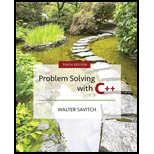
Write a
The user is asked how many cards she or he has, and the user responds with one of the integers 2, 3, 4, or 5. The user is then asked for the card values. Card values are 2 through 10, jack, queen, king, and ace. A good way to handle input is to use the type char so that the card input 2, for example, is read as the character '2', rather than as the number 2. Input the values 2 through 9 as the characters '2' through '9'. Input the values 10, jack, queen, king, and ace as the characters 't', 'j', 'q', 'k', and 'a'. (Of course, the user does not type in the single quotes.) Be sure to allow upper- as well as lowercase letters as input.
After reading in the values, the program should convert them from character values to numeric card scores, taking special care for aces. The output is either a number between 2 and 21 (inclusive) or the word Busted. You are likely to have one or more long multiway branches that use a switch statement or nested if-else statement. Your program should include a loop that lets the user repeat this calculation until the user says she or he is done.
Want to see the full answer?
Check out a sample textbook solution
Chapter 3 Solutions
Problem Solving with C++ (10th Edition)
Additional Engineering Textbook Solutions
Electric Circuits. (11th Edition)
Degarmo's Materials And Processes In Manufacturing
Concepts Of Programming Languages
Introduction To Programming Using Visual Basic (11th Edition)
Starting Out with C++ from Control Structures to Objects (9th Edition)
Java: An Introduction to Problem Solving and Programming (8th Edition)
 EBK JAVA PROGRAMMINGComputer ScienceISBN:9781337671385Author:FARRELLPublisher:CENGAGE LEARNING - CONSIGNMENT
EBK JAVA PROGRAMMINGComputer ScienceISBN:9781337671385Author:FARRELLPublisher:CENGAGE LEARNING - CONSIGNMENT C++ for Engineers and ScientistsComputer ScienceISBN:9781133187844Author:Bronson, Gary J.Publisher:Course Technology Ptr
C++ for Engineers and ScientistsComputer ScienceISBN:9781133187844Author:Bronson, Gary J.Publisher:Course Technology Ptr C++ Programming: From Problem Analysis to Program...Computer ScienceISBN:9781337102087Author:D. S. MalikPublisher:Cengage Learning
C++ Programming: From Problem Analysis to Program...Computer ScienceISBN:9781337102087Author:D. S. MalikPublisher:Cengage Learning Microsoft Visual C#Computer ScienceISBN:9781337102100Author:Joyce, Farrell.Publisher:Cengage Learning,
Microsoft Visual C#Computer ScienceISBN:9781337102100Author:Joyce, Farrell.Publisher:Cengage Learning, EBK JAVA PROGRAMMINGComputer ScienceISBN:9781305480537Author:FARRELLPublisher:CENGAGE LEARNING - CONSIGNMENT
EBK JAVA PROGRAMMINGComputer ScienceISBN:9781305480537Author:FARRELLPublisher:CENGAGE LEARNING - CONSIGNMENT Operations Research : Applications and AlgorithmsComputer ScienceISBN:9780534380588Author:Wayne L. WinstonPublisher:Brooks Cole
Operations Research : Applications and AlgorithmsComputer ScienceISBN:9780534380588Author:Wayne L. WinstonPublisher:Brooks Cole





